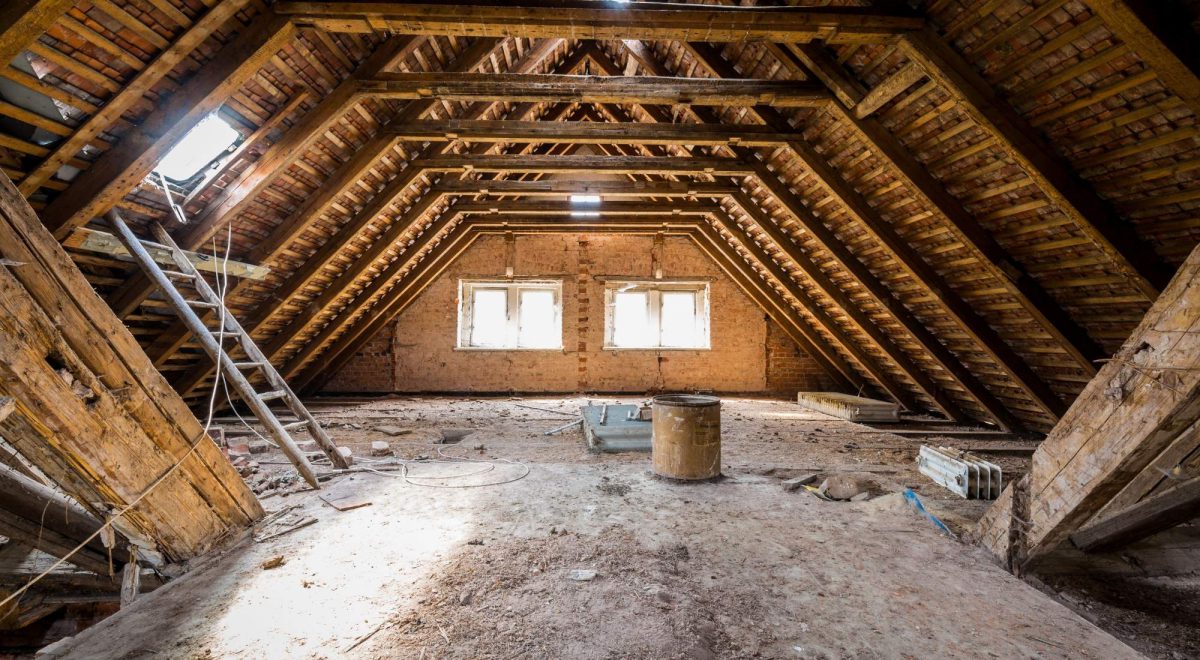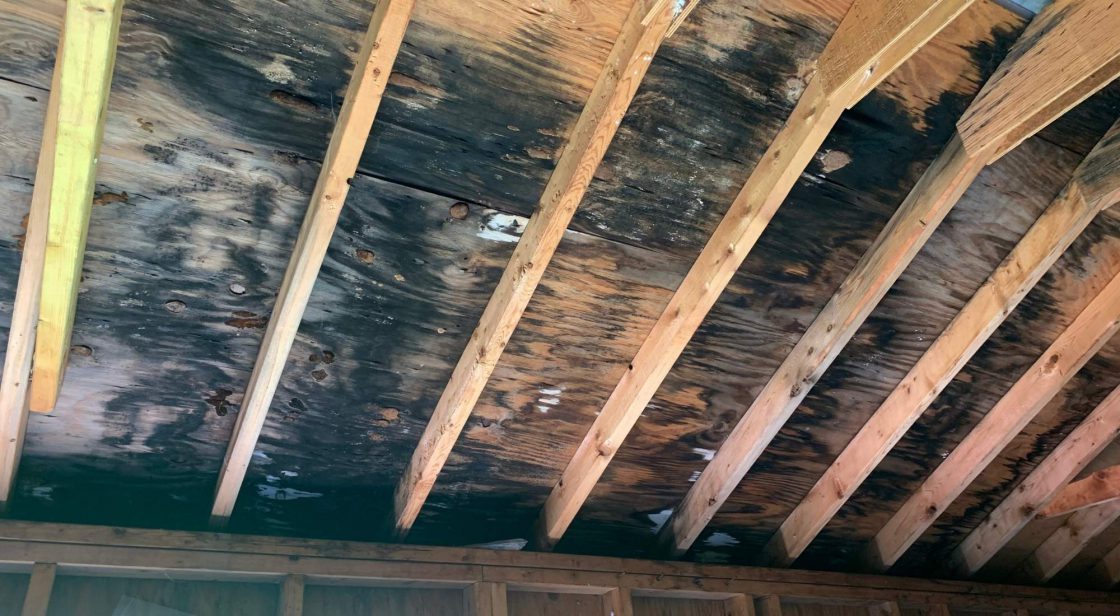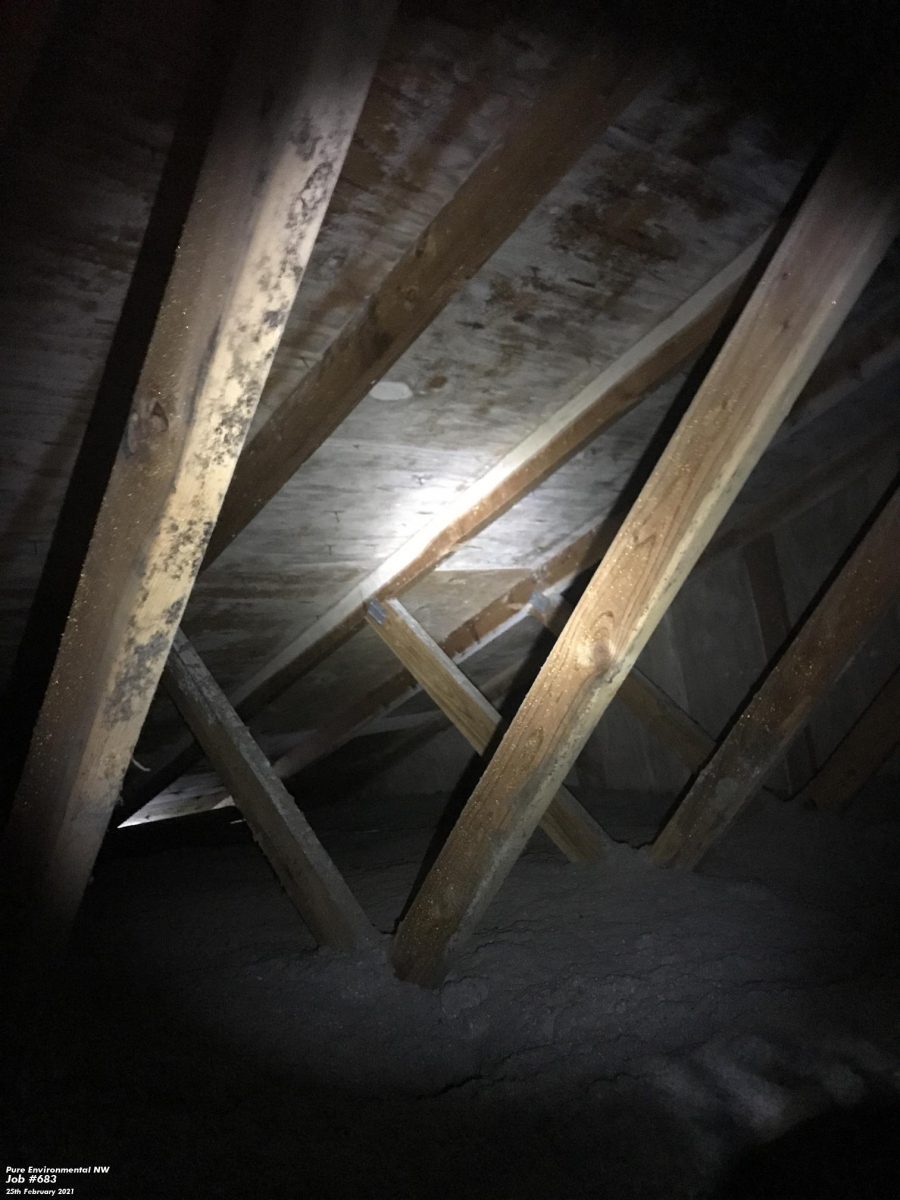The attic. For many people, it’s a forgotten-about room in the house. Maybe you make your way up there every few months to drag down the holiday decorations or your rarely-used camping gear.
Family memorabilia, tools, unused furniture––all things you might find in a typical attic.
Another thing that might be lurking in your attic?
Mold.
Read on to learn all about attic mold that may be a health hazard to you and your family, how to remove that mold, and most importantly, how to tackle the root of your mold problem to ensure it doesn’t return.
Table of Contents
- What Causes Attic Mold?
- 5 Signs You May Have Attic Mold
- How to Get Rid of Mold in Attic Spaces and Other Hard-to-Reach Areas
- Safety Precautions to Take When Removing Mold Yourself
- Mold Remediation: Getting to the Root of the Problem
- Pure Environmental Knows How to Remove Mold From Attics and Prevent it From Returning
What Causes Attic Mold?
Mold is a result of moisture, something we’re certainly not lacking in Washington and Oregon.
That’s why mold is both extremely common and difficult to prevent in the Pacific Northwest.
Some typical causes of mold in the attic include:
- Roof leaks
- Improperly ventilated attics
- Inadequate, missing, or damaged insulation
- Unsealed openings in ceilings
- Improperly vented fans or appliances
- Improperly installed rain gutters

How Serious Is Attic Mold?
To put it simply, mold may very well lead to safety issues. If mold gets into your HVAC system, it can cause asthma attacks and respiratory issues.
Symptoms from exposure to mold and mildew include:
- Coughing
- Wheezing
- Sneezing
- Running nose
- Nasal congestion
- Sore throat; and
- Irritation of the skin, eyes, nose, throat, and lungs
These symptoms can vary from mild to severe.
Aside from health concerns, mold can cause considerable structural damage to your home.
So, can you live with mold in your attic?
No, it is absolutely not recommended. Once you have identified any mold in an …
- Attic
- Crawlspace
- Basement, or
- Anywhere else in your home
… it needs to be removed as soon as possible.
5 Signs You May Have Attic Mold
The fact is, most people don’t check their attics for mold.
Instead, mold is typically discovered by home inspectors during real estate transactions, contractors, pest control, or other service providers. And when that happens, who knows how long it’s been there?
Here’s the thing: you should be checking your attic for mold regularly––especially when you live in the wet and rainy Pacific Northwest.
Plan on checking your attic for mold every six months. To make it easy on yourself, make a mental note to check your attic at the same time you check or change the batteries on your smoke detectors. For many people, daylight savings time is the perfect time for home maintenance tasks like these because “falling back” or “springing forward” provides a built-in bi-annual reminder (at least for now).
So, twice a year, head up to the attic in search of signs of mold.
Here’s what you should be on the lookout for:
- Dark stains on the plywood
- Sunken or wet insulation
- Mildew smell
- Hot and stuffy air
- Condensation or frost buildup on the roof sheathing
It’s important to keep in mind that mold isn’t always visible, so if you notice one or more of these signs, you should have an expert inspect and test for mold.

#1: Dark Stains on the Plywood
Take a look at the wood surfaces in your attic.
Do you notice any dark stains?
If so, you’ve likely got a mold problem on your hands.
#2: Wet or Sunken Insulation
Next, you’ll want to check out the insulation.
Does it feel wet? Is it sunken due to excess moisture?
These signs are often an indication that mold will develop––if it hasn’t already.
#3: The Smell of Mildew
Take a deep breath through your nose. You may sneeze as attics are notoriously dusty.
Take another deep breath and really take notice of your nose. Is the smell musty and moldy?
If so, you may be in trouble. There’s a reason people say “trust your nose” or “the nose knows.”
It’s because the nose doesn’t lie. If you’re smelling something that doesn’t seem quite right, it’s probably time to call in a professional.
#4: The Air Is Hot and Stuffy
How does it feel when you step into your attic?
Depending on the season, an attic should feel a bit drafty, assuming it’s well-ventilated.
If, on the contrary, the air feels stagnant, humid, hot, and stuffy, it could be a sign of excess moisture, a prerequisite for mold.
#5: You Have Condensation on the Roof Sheathing
If it’s fall, winter, or even early spring, take special note of the roof sheathing.
If it looks normal and dry, it’s a good sign.
However, if you notice condensation, it’s a reason for concern and probably warrants additional investigation.
How to Get Rid of Mold in Attic Spaces and Other Hard-to-Reach Areas
You’ve identified a mold problem. What now?
How do you get rid of mold in your attic?
There’s no question, the absolute best way to get rid of harmful mold is to hire a professional.
Sure, you may come across several DIY solutions for mold removal on the internet or when you ask friends or neighbors. But when it comes to something as serious and potentially dangerous as mold, it’s a project that should be left up to the experts.
Hire a Professional
Mold removal is serious business. That’s why hiring a professional is recommended. It’s the best way to ensure you’ve not only removed all of the dangerous mold, but also identified what’s causing that mold and then fixed the issue.
You need to make your home and family environment PURE again. That’s where the mold removal experts at Pure Environmental Solutions come in.
Our team will:
- Identify the problem.
- Physically remove the mold.
- Clean the area.
- Disinfect and treat the area.
- Address and fix the root of the problem, preventing future mold.
Call the most thorough mold abatement specialists in the PNW for a free estimate today. After all, for the health and safety of you and your family, if you’ve got mold, it’s vital to tackle the issue ASAP.
Removing Mold With Vinegar
So, you know hiring a professional is what’s recommended, but you’re still wondering, how do I treat mold in my attic?
While not the most thorough or efficient, you can try some DIY treatments for mold removal. These amateur remediation methods will take a few hours and a lot of elbow grease.
Maybe you Googled “how to get rid of mold in attic” and the search results tell you to try vinegar.
Regular white distilled vinegar can be used to:
- Clean
- Deodorize; and
- Disinfect surfaces
To remove the mold, you’ll need to:
- Open windows and doors where possible to allow ventilation in your attic.
- Wear protective gloves and goggles.
- Pour undiluted vinegar into a spray bottle.
- Generously spray vinegar directly on surfaces where you see mold.
- Let the vinegar sit for an hour or more.
- Scrub moldy surfaces with a soft-bristle brush, removing the mold.
- Dry the surface with a clean cloth.
- Dispose of brush and cloth as mold residue may remain.
Some studies have shown vinegar can remove up to 82% of mold.
Is up to 82% enough for you and your family?
Think about spending a few hours of your weekend removing mold, only to have it return.
That’s why hiring a professional to both remove mold and prevent it from returning is your best bet.
Removing Mold With Alcohol
Another DIY removal tip you may find on the web?
Alcohol. Though to clarify, don’t try to use whatever you can find in the liquor cabinet––you’ll need Isopropyl alcohol, typically referred to as rubbing alcohol.
If you attempt to remove mold from your attic using alcohol, you’ll follow the same instructions as with vinegar, simply replacing the vinegar with Isopropyl alcohol.
Removing Mold With a Home or Shop Vacuum
This is not a recommended mold removal method. That’s because it’s not a job for standard household vacuums or even household shop vacuums.
Yes, professionals use this method as a PART of their mold remediation process, however, they are using professional-grade HEPA vacuums.
Remember, mold is serious business. It’s not something to mess around with.

Safety Precautions to Take When Removing Mold Yourself
Mold can be harmful to your health, as can some of the materials used to remove mold.
If you opt to take on mold removal yourself, you’ll want to take some necessary safety precautions.
These precautions include:
- Wearing safety goggles, gloves, and respirator or mask over your mouth and nose (an N-95 mask is the minimum safety standard).
- Wearing old clothing and shoes that you can either wash or dispose of after completion of mold removal. Ideally a disposable bunny suit that includes built in booties and hood should be worn.
- Using cleaning brushes, cloths, and towels you can dispose of after use.
- Ventilating the room as best you can by opening doors, windows and setting up fans while you work on mold removal. Ideally the area should be contained from the rest of the structure combined with HEPA air scrubbing and negative airflow
Mold Remediation: Getting to the Root of the Problem
So you’ve got mold. But what’s causing it? Why is this happening?
It’s not enough just to remove the mold. If it was there before, it will likely return.
That’s why it’s essential to get to the root of the problem. Not just that, once you’ve found what’s causing the excess moisture, you’ll need to address it. That may mean:
- Fixing a leaky roof
- Addressing structural ventilation
- Addressing appliance ventilation
- Air seal between living space and attic
- Proper insulation
Pure Environmental Knows How to Remove Mold From Attics and Prevent it From Returning
The team at Pure Environmental knows mold. After all, we live and work in the Pacific Northwest, which is green and beautiful – but also known for an abundance of wet, rainy days. All that rain means excess moisture, a key component for mold and mildew growth.
If you’ve got a mold problem, Pure Environmental is the solution. We’re mold abatement specialists and we’ve seen (and handled) it all.
When you call Pure Environmental to take on the mold in your attic (and anywhere else it might be growing), here’s what you can expect:
- Our team will conduct a thorough initial mold inspection, partnering with local laboratories for collecting and testing samples, if necessary.
- Once mold presence is confirmed, Pure Environmental establishes a “containment zone.”
- Within that zone, we determine whether any wood, drywall, insulation, etc. need to be removed as part of the mold removal treatment.
- After removing any necessary materials, our experts will thoroughly abrade and clean all affected surfaces with HEPA filtered vacuums, designed to capture fine particles.
- Next, we’ll apply our special cleaning agents to mitigate any remaining mold and treat the entire work area with a registered, hospital grade disinfectant.
- If desired, the attic sheathing can also be encapsulated with a clear antimicrobial coating, however, we feel that it is much more important to correct the ventilation concerns to prevent future mold growth
- If necessary, our team will again partner with a local lab for additional testing to ensure mold remediation is successful and complete.
- Finally, the mold abatement professionals at Pure Environmental can repair or replace any secondarily affected materials and come up with a restoration plan for any impacted areas.
As you can see, this process is significantly more effective and thorough than what you’ll get with vinegar, a spray bottle, and a scrub brush.
If you’re looking for results. If you’re looking to return your attic to a safe, dry, structure, look no further than the pros at Pure Environmental.

Recent posts
- Should You Stay or Should You Go? Know When To Walk Away From a House With Mold
- How To Get Rid of Weed Smell: Top Tips To Help Cannabis Users and Growers Keep Their Homes Smelling Fresh and Clean
- HVAC System Longevity and Understanding When It’s Time To Replace Yours
- How To Remove Mold From Basement Walls: Guidance for Safe Mold Removal Practices
- Uncovering the Truth About Black Mold: A Guide, FAQs, and More